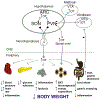Translational and therapeutic potential of oxytocin as an anti-obesity strategy: Insights from rodents, nonhuman primates and humans
- PMID: 26013577
- PMCID: PMC6235440
- DOI: 10.1016/j.physbeh.2015.05.023
Translational and therapeutic potential of oxytocin as an anti-obesity strategy: Insights from rodents, nonhuman primates and humans
Abstract
The fact that more than 78 million adults in the US are considered overweight or obese highlights the need to develop new, effective strategies to treat obesity and its associated complications, including type 2 diabetes, kidney disease and cardiovascular disease. While the neurohypophyseal peptide oxytocin (OT) is well recognized for its peripheral effects to stimulate uterine contraction during parturition and milk ejection during lactation, release of OT within the brain is implicated in prosocial behaviors and in the regulation of energy balance. Previous findings indicate that chronic administration of OT decreases food intake and weight gain or elicits weight loss in diet-induced obese (DIO) mice and rats. Furthermore, chronic systemic treatment with OT largely reproduces the effects of central administration to reduce weight gain in DIO and genetically obese rodents at doses that do not appear to result in tolerance. These findings have now been recently extended to more translational models of obesity showing that chronic subcutaneous or intranasal OT treatment is sufficient to elicit body weight loss in DIO nonhuman primates and pre-diabetic obese humans. This review assesses the potential use of OT as a therapeutic strategy for treatment of obesity in rodents, nonhuman primates, and humans, and identifies potential mechanisms that mediate this effect.
Keywords: Energy expenditure; Food intake; Obesity; Oxytocin.
Published by Elsevier Inc.
Figures

Similar articles
-
Intranasal oxytocin reduces weight gain in diet-induced obese prairie voles.Physiol Behav. 2018 Nov 1;196:67-77. doi: 10.1016/j.physbeh.2018.08.007. Epub 2018 Aug 23. Physiol Behav. 2018. PMID: 30144467 Free PMC article.
-
Chronic hindbrain administration of oxytocin is sufficient to elicit weight loss in diet-induced obese rats.Am J Physiol Regul Integr Comp Physiol. 2017 Oct 1;313(4):R357-R371. doi: 10.1152/ajpregu.00169.2017. Epub 2017 Jul 26. Am J Physiol Regul Integr Comp Physiol. 2017. PMID: 28747407 Free PMC article.
-
Chronic oxytocin administration inhibits food intake, increases energy expenditure, and produces weight loss in fructose-fed obese rhesus monkeys.Am J Physiol Regul Integr Comp Physiol. 2015 Mar 1;308(5):R431-8. doi: 10.1152/ajpregu.00441.2014. Epub 2014 Dec 24. Am J Physiol Regul Integr Comp Physiol. 2015. PMID: 25540103 Free PMC article.
-
Role of oxytocin signaling in the regulation of body weight.Rev Endocr Metab Disord. 2013 Dec;14(4):311-29. doi: 10.1007/s11154-013-9260-x. Rev Endocr Metab Disord. 2013. PMID: 24065622 Free PMC article. Review.
-
Oxytocin as an Anti-obesity Treatment.Front Neurosci. 2021 Oct 13;15:743546. doi: 10.3389/fnins.2021.743546. eCollection 2021. Front Neurosci. 2021. PMID: 34720864 Free PMC article. Review.
Cited by
-
A randomized, double-blind, placebo-controlled clinical trial of 8-week intranasal oxytocin administration in adults with obesity: Rationale, study design, and methods.Contemp Clin Trials. 2022 Nov;122:106909. doi: 10.1016/j.cct.2022.106909. Epub 2022 Sep 7. Contemp Clin Trials. 2022. PMID: 36087842 Free PMC article. Clinical Trial.
-
Peripherally restricted oxytocin is sufficient to reduce food intake and motivation, while CNS entry is required for locomotor and taste avoidance effects.Diabetes Obes Metab. 2023 Mar;25(3):856-877. doi: 10.1111/dom.14937. Epub 2023 Jan 9. Diabetes Obes Metab. 2023. PMID: 36495318 Free PMC article.
-
Oxytocin reduces the functional connectivity between brain regions involved in eating behavior in men with overweight and obesity.Int J Obes (Lond). 2020 May;44(5):980-989. doi: 10.1038/s41366-019-0489-7. Epub 2019 Nov 18. Int J Obes (Lond). 2020. PMID: 31740723 Free PMC article. Clinical Trial.
-
Oxytocin alterations and neurocognitive domains in patients with hypopituitarism.Pituitary. 2019 Apr;22(2):105-112. doi: 10.1007/s11102-019-00936-0. Pituitary. 2019. PMID: 30656597
-
Crosstalk between Schizophrenia and Metabolic Syndrome: The Role of Oxytocinergic Dysfunction.Int J Mol Sci. 2022 Jun 25;23(13):7092. doi: 10.3390/ijms23137092. Int J Mol Sci. 2022. PMID: 35806096 Free PMC article. Review.
References
-
- Eckel RH, Grundy SM, Zimmet PZ, The metabolic syndrome, Lancet 365 (2005) 1415–1428. - PubMed
-
- Grundy SM, Metabolic syndrome pandemic, Arterioscler. Thromb. Vasc. Biol 28 (2008) 629–636. - PubMed
-
- Smyth S, Heron A, Diabetes and obesity: the twin epidemics, Nat. Med 12 (2006) 75–80. - PubMed
-
- Finkelstein EA, Trogdon JG, Cohen JW, Dietz W, Annual medical spending attributable to obesity: payer-and service-specific estimates, Health Aff 28 (2009) w822–w831. - PubMed
Publication types
MeSH terms
Substances
Grants and funding
LinkOut - more resources
Full Text Sources
Other Literature Sources
Medical

